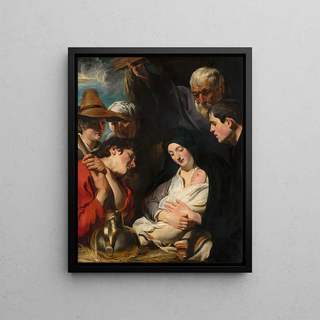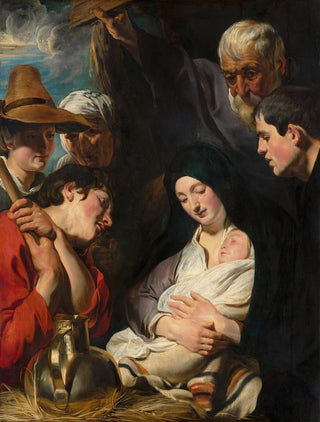Art print | The Adoration of the Shepherds - Jacob Jordaens


View from behind

Frame (optional)
Art print of The Adoration of the Shepherds - Jacob Jordaens – Captivating Introduction
In the world of Baroque art, few works manage to capture the essence of joy and wonder like "The Adoration of the Shepherds" by Jacob Jordaens. This iconic piece, created in the heart of the 17th century, immerses the viewer in a scene of devotion and tenderness, where divine light illuminates the faces of the characters. This depiction of the Nativity, vibrant with colors and life, embodies not only Christian spirituality but also the warmth of human interaction that emanates from the figures. Through this work, Jordaens invites us to share a sacred moment, where every gaze and gesture reveals a depth of emotion.
Style and uniqueness of the work
Jordaens' style is distinguished by his ability to blend the grandeur of Baroque with an intimate approach. In "The Adoration of the Shepherds," the characters are portrayed with a monumentality that evokes both divine power and human fragility. The shimmering colors, typical of his oeuvre, create a warm and welcoming atmosphere, where gold and deep reds dominate the scene. The light, skillfully orchestrated, highlights the face of the Infant Jesus, emphasizing the sacred significance of the moment. The composition is dynamic, with each figure carefully arranged to direct the viewer's gaze toward the center of the work, while maintaining a harmonious balance. Jordaens succeeds in capturing movement and emotion, making the scene almost tangible, as if one could hear the whispers of the shepherds and feel the gentle night air.
The artist and his influence
Jacob Jordaens, born in Antwerp in 1593, is one of the masters of Flemish Baroque, alongside Rubens and Van Dyck. His prolific career is marked by a unique approach to painting, where he merges realism and symbolism, while incorporating folkloric elements. Jordaens often draws inspiration from everyday life and popular traditions, allowing him to create works that resonate deeply with the public. His influence extends far beyond his time, as he has

Matte finish

View from behind

Frame (optional)
Art print of The Adoration of the Shepherds - Jacob Jordaens – Captivating Introduction
In the world of Baroque art, few works manage to capture the essence of joy and wonder like "The Adoration of the Shepherds" by Jacob Jordaens. This iconic piece, created in the heart of the 17th century, immerses the viewer in a scene of devotion and tenderness, where divine light illuminates the faces of the characters. This depiction of the Nativity, vibrant with colors and life, embodies not only Christian spirituality but also the warmth of human interaction that emanates from the figures. Through this work, Jordaens invites us to share a sacred moment, where every gaze and gesture reveals a depth of emotion.
Style and uniqueness of the work
Jordaens' style is distinguished by his ability to blend the grandeur of Baroque with an intimate approach. In "The Adoration of the Shepherds," the characters are portrayed with a monumentality that evokes both divine power and human fragility. The shimmering colors, typical of his oeuvre, create a warm and welcoming atmosphere, where gold and deep reds dominate the scene. The light, skillfully orchestrated, highlights the face of the Infant Jesus, emphasizing the sacred significance of the moment. The composition is dynamic, with each figure carefully arranged to direct the viewer's gaze toward the center of the work, while maintaining a harmonious balance. Jordaens succeeds in capturing movement and emotion, making the scene almost tangible, as if one could hear the whispers of the shepherds and feel the gentle night air.
The artist and his influence
Jacob Jordaens, born in Antwerp in 1593, is one of the masters of Flemish Baroque, alongside Rubens and Van Dyck. His prolific career is marked by a unique approach to painting, where he merges realism and symbolism, while incorporating folkloric elements. Jordaens often draws inspiration from everyday life and popular traditions, allowing him to create works that resonate deeply with the public. His influence extends far beyond his time, as he has






